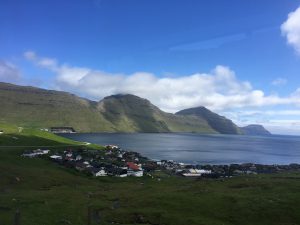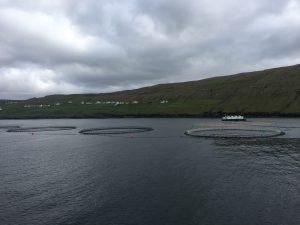Aquaculture is the fastest growing food production sector in the past 20 years. It will become vital in meeting the rapidly increasing demand for seafood, and is expected to provide 50 per cent of total seafood consumed in the coming years.[i] Contributing to an increased protein supply and global food security, aquaculture also carries many risks. These risks include the potential spread of diseases and parasites, use of antibiotics and pesticides, and the escape of fish from fish farms which can jeopardize wild populations.
The Faroe Islands is a good example of where such risks have been managed properly. In recent years, aquaculture has grown rapidly in the Faroes and the country has become a key player in the international market. Farmed fish now represents half of the country’s export value and the aquaculture industry provides jobs for communities across the islands.[ii] In June 2019, Sustainalytics visited the islands as part of the Sustainable Seafood Engagement, to study real-life management best practices at fish farms and learn about the factors contributing to the success of the Faroese fish farming industry.
Geography
Geography plays an important role in the aquaculture industry’s success. The clean, temperate oceanic waters and strong currents in the fjords and straits around the Faroe Islands are ideal for fish farming. As a result, the number of sea lice, which has a huge impact on fish welfare and is one of the biggest challenges for aquaculture, is relatively low. This means Faroese fish farms have the unique distinction of not needing to use antibiotic treatments. Instead, non-medical treatment of fish is sufficient, and has a positive influence on both animal welfare and the environment.
Another positive geographical aspect is the size of the islands. As the Faroes are relatively small, the transport times between different stages of the production chain are very short, which helps to maintain fish welfare.


Business Environment and Government Regulation
To ensure sustainability, the number of farm fish licenses issued in the Faroes is strictly limited, as are the locations where aquaculture is allowed. The Faroese aquaculture industry is quite consolidated both horizontally and vertically, with only a handful of companies in the islands producing and exporting salmon. Due to this integration, producers have full control over the entire production chain. This facilitates complete traceability, from roe to final export product, including the feed used in Faroese aquaculture.
Governmental oversight has also influenced the aquaculture industry’s success. The Faroe Islands have a strong regulatory framework in place, and in 2003 the country implemented some of the world’s most stringent and comprehensive regimes for veterinary aquaculture monitoring. The Faroese Veterinarian Act on Aquaculture has been highly effective, resulting in the local industry showing some of the best results globally on mortality rates, smolt yield and biological feed conversion ratio. The Act has also been used as inspiration and guidance for the implementation of sustainable aquaculture standards in other countries.[iii]
The small size of the corporate sector and strong sense of community in the islands has made it easier for the industry to cooperate and agree on unregulated matters and avoid a tragedy of the commons. This has facilitated effective stakeholder participation, communication and collaboration on a wide range of common, practical challenges and issues of shared interest.
A unique feature for the Faroese system is the “All In – All Out” policy, which has been vital for the health of the farmed fish. The policy, introduced to combat and prevent the spread of diseases, limits each production site to one generation of fish at a time. Following the harvest, all farming in that fjord is suspended for a period of at least two months, allowing the strong North Atlantic currents to clean the site while it lies fallow. This ensures a healthy environment and promotes proper animal welfare. The site must then be re-approved by the Food and Veterinary Agency before the next generation of fish can be placed in the fjord.
The policy is a good manifestation of the interplay between strong governance and common interest, resulting in added value not only for the industry but for the entire community, while also protecting the commons. This is the core of the Faroese model, which more societies and industries should take inspiration from.
For more information about the Sustainable Seafood Engagement, please contact [email protected]




